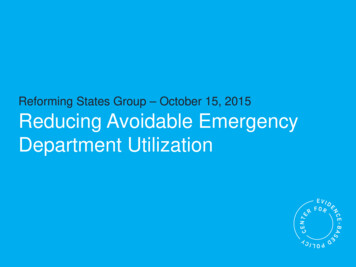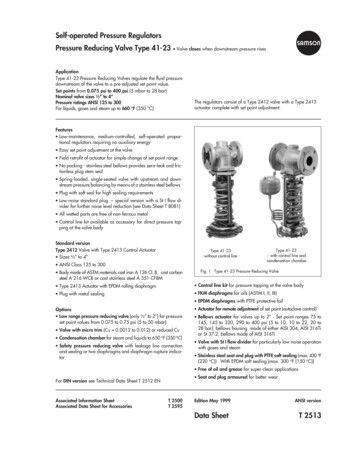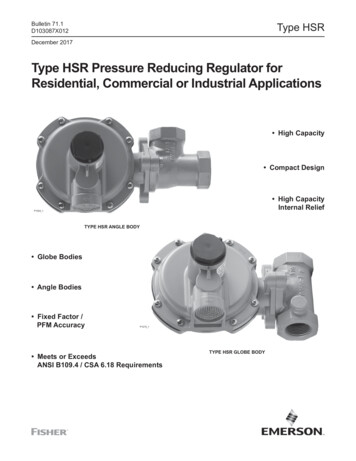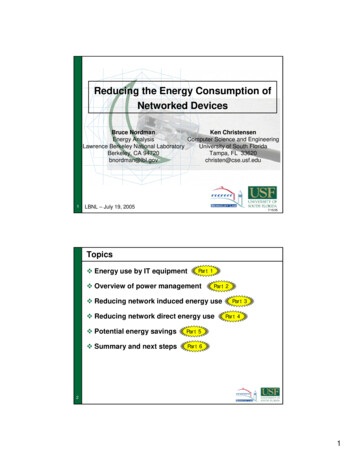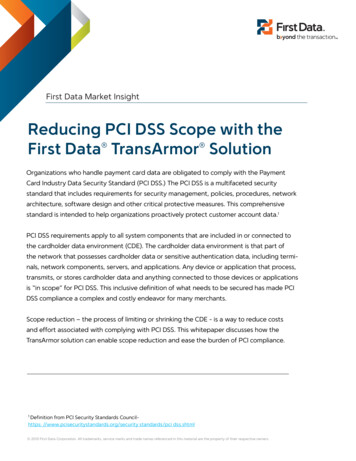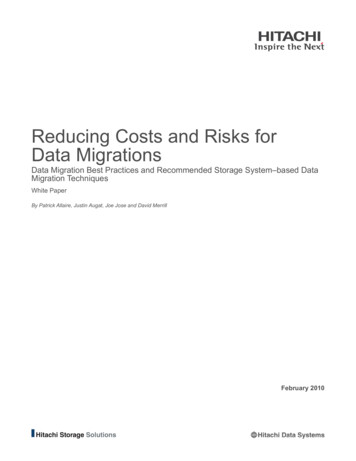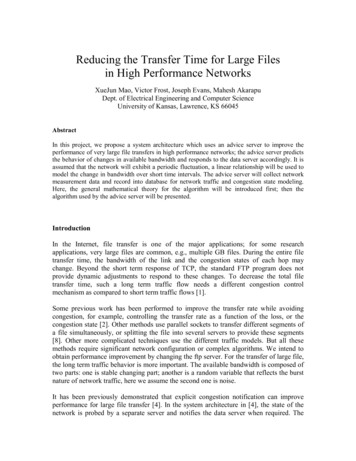
Transcription
Reducing the Transfer Time for Large Filesin High Performance NetworksXueJun Mao, Victor Frost, Joseph Evans, Mahesh AkarapuDept. of Electrical Engineering and Computer ScienceUniversity of Kansas, Lawrence, KS 66045AbstractIn this project, we propose a system architecture which uses an advice server to improve theperformance of very large file transfers in high performance networks; the advice server predictsthe behavior of changes in available bandwidth and responds to the data server accordingly. It isassumed that the network will exhibit a periodic fluctuation, a linear relationship will be used tomodel the change in bandwidth over short time intervals. The advice server will collect networkmeasurement data and record into database for network traffic and congestion state modeling.Here, the general mathematical theory for the algorithm will be introduced first; then thealgorithm used by the advice server will be presented.IntroductionIn the Internet, file transfer is one of the major applications; for some researchapplications, very large files are common, e.g., multiple GB files. During the entire filetransfer time, the bandwidth of the link and the congestion states of each hop maychange. Beyond the short term response of TCP, the standard FTP program does notprovide dynamic adjustments to respond to these changes. To decrease the total filetransfer time, such a long term traffic flow needs a different congestion controlmechanism as compared to short term traffic flows [1].Some previous work has been performed to improve the transfer rate while avoidingcongestion, for example, controlling the transfer rate as a function of the loss, or thecongestion state [2]. Other methods use parallel sockets to transfer different segments ofa file simultaneously, or splitting the file into several servers to provide these segments[8]. Other more complicated techniques use the different traffic models. But all thesemethods require significant network configuration or complex algorithms. We intend toobtain performance improvement by changing the ftp server. For the transfer of large file,the long term traffic behavior is more important. The available bandwidth is composed oftwo parts: one is stable changing part; another is a random variable that reflects the burstnature of network traffic, here we assume the second one is noise.It has been previously demonstrated that explicit congestion notification can improveperformance for large file transfer [4]. In the system architecture in [4], the state of thenetwork is probed by a separate server and notifies the data server when required. The
network probing and advising service is proved valuable to enhance the performance ofdata server, e.g., one implementation is Network Characterization Service (NCS) [6]Many tools are available to perform network testing, such as iperf[12], pchar[13],pipechar[11]. While these tools can provide information about current network state, theycan not predict traffic trends, which is necessary to adjust parameter during large filetransfer. A database is needed to collect all the data from these tests, while file transferparameters are adjusted according to the network traffic history data with certainalgorithm. This database will record all the information collected by the measurementtools. We seek a balance between the congestion control and high performance. Hencethe network state determination is an important aspect of this project; from the networkstate, we can calculate the proper parameters for file transfer.In this project, we model the changes in available bandwidth and use the result toimprove large file transfer performance, the goal is to reduce total transfer time. Thecongestion state for file transfer will be determined by the response obtained from anadvice server. Moreover, one of important methods to improve performance is to use theoptimal TCP buffer size. The optimal TCP buffer size can be calculated by followingformula [3]:optimal TCP buffer RTT * (bandwidth of bottleneck link)For relatively short files, bandwidth can be assumed to be constant; but for very largefiles, a model is needed to build to predict when to adjust the optimal TCP buffer.Another hypothesis here is that if there is no congestion in the link, we can turn offcongestion control and set the optimal TCP buffer size to get better performance. So wealso monitor the congestion state of the link from server to client. The architecture of thesystem considered is shown in Figure 1.Advice ServerClientInternet statedt anuesqericenseAdv respoData ServerFigure 1 System architectureHistory data
The important components are:·Data server: data server stores the file to be transferred and provides service forcustomers. The data server is unaware of the network state, it requires the adviceserver to provide parameters for file transfer and communicates with client to setthese parameters.·Advice server: advice server continuously collects the network state, the resultsare stored in a database. When the data server sends an advice request, the adviceserver analyzes the data in database and provides suggested parameters for thetransfer.Background and PrincipleThe data collected of available bandwidth from internet shows that the network trafficexhibits a periodic behavior, although the change in available bandwidth is not smooth,as shown in Figure 2. Typically, the available bandwidth will increase at night anddecrease in the day.Figure 2 Observed available bandwidthFigure 2 is a typical change in available bandwidth for a router output port for one day.The thick curve is two hour moving average.In our model, we regard the available bandwidth as being composed of two parts: one isdeterministic; another is random to reflect the burstyness of network traffic, it can betaken as noise. For the first part, a linear regression method is used to model the trafficfor short time intervals; that is, at any time we assume a linear relationship between timeand available bandwidth over a short period of time. For example, when the advice serverreceives request at 2:00 am, it calculates the mean available bandwidth and bandwidthrate of change at 2:00 am according to historical data.
Assume the relationship between available bandwidth and time is a linear,b b0 b t1b represents available bandwidtht represents time relative to the request timeb 0 will be the available bandwidth at the time of the request, b1 will be rate of change ofthe available bandwidth, it may be negative.Figure 3 Illustration of linear modelIn Figure 3, the advice request arrives at time t 0 . The linear regression is done for databetween t 0 and t1 ( Dt1 t1 - t 0 is a configured constant). b 0 will be the availablebandwidth at t 0 , b1 is the slope, representing the rate of change in available bandwidth. Ifwe require that the change in available bandwidth will not exceed Db , then the nextadvice time will be t a .The database in the advice server will contain a series of observed pairs (bi , t i ), i 1, K n,from which the estimators of the coefficients b 0 , b1 can be calculated, that is,n å b t - ( å b )( å t )i iii22n å t - (å t )iiˆå bi - b1 å t ibˆ 0 nbˆ1 The measurement contains noise so that the model becomesbi b 0 b1t i e i
We assume that:·e i is a Gaussian random variable·Mean value of e i is 0, i.e., E (e i ) 0·Variance of e i is constant. (Therefore, e i N (0, s 2 ) )Correlation of e i and e j ( i ¹ j ) is 0·Correlation of e i and bi is 0·Under these assumptions:·b̂1 is an unbiased estimator of b1b̂ 0 is an unbiased estimator of b 0·The goodness of fitness is measured by·R22å (bi - ( bˆ 0 bˆ1t i )) 122å bi - ( å bi ) / nImplementation of Advice ServerCurrently we use pipechar[11] to collect available bandwidth data. Each time pipechar isexecuted, it reports the available bandwidth and congestion state for each hop from thedate server to the potential client. The advice server maintains a database, which recordsthe following observations(ip,t , b, c)ip is the ip address of each hop, t is test time, b is measured available bandwidth at thishop and time t , c is a Boolean that indicates whether congestion is occurring (TRUE) ornot (FALSE) at this hop and time t .When the data server receives a file transfer request from client, it sends a request to theadvice server. The request include the following parameters:·ip address of client·file length or remaining file length to be transferredWhen the advice server receives the request, it determines the following parameters tosend back to the data server:·Flag to indicate whether to use congestion control or not in TCP·RTT from server to client.·Current available bandwidth·Next advice timeRTT can be tested when the advice request arrives at the advice server, either ICMPprogramming or ping can be used to obtain the result. To get the congestion control flag,
the advice server searches for the most recent observation of this destination fromdatabase. The result is a series of stored information in the form of(ip1 ,t , b1 , c1 ) (ip n ,t , bn , c n )Here, ip i s are ip addresses of hops from the server to the destination, bi s are availablebandwidth of corresponding hops, ci s are flags of congestion states. If the most recenttest time t is not close enough to current time, the congestion control flag is set to informthe data server to use congestion control during transmission. If the nearest test time t isclose enough to current time, the congestion control flag is determined by congestionflags. If anyone of them is TRUE, which means congestion exists at this hop, thecongestion control flag will be turned on; if none of them is true, the congestion controlflag will be turned off.The available bandwidth and next advice time will be calculated according to historicaldata of the minimum bandwidth hop. When an advice request arrives, the first step is tocalculate the available bandwidth and rate of change of available bandwidth for eachprevious day with test data.day 10t0Dt 1t1day 20t0Dt 1t1Figure 4 Illustration of calculationThe advice request comes at time t 0 in current day. For each previous day illustrated inFigure 4, we do linear regression for history data from t 0 to t1 t 0 Dt1 ; then we getavailable bandwidth b 0 (i ) and rate of change in available bandwidth b1 (i ) , i is the indexof the previous days.Current available bandwidth will be estimated as the mean value of series b 0 (i )1 Nå b 0 (i) , N is total number of days.N i 1This value will be sent back to the data server.b0 For the rate of change in available bandwidth b1 (i ) , we calculate the mean value b1 andstandard deviation s b1 , then the rate of change in available bandwidth will be betweenb1 - t zs b1 and b1 t zs b1 ( t z is determined by confident level requirement of normaldistribution. According to theory, b1 (i ) has student-t probability distribution function,hence b1 (i ) can be approximated by normal distribution. For example, t z 2 is for 95%confidence).
Denote S max( b1 - t zs b1 , b1 t zs b1 ) , S will be the maximum rate of change inavailable bandwidth. That is, from t 0 , after a certain time interval t , the maximumchange in available bandwidth will be S t .The upper bound of tolerated change in available bandwidth can be determined either byabsolute value or percent of estimated bandwidth b 0 , denote it as Db . ThenS t Db Þ t Db / Swhich gives the next advice time t a t 0 t .Data CollectionCurrently the traffic data from interface 164.113.234.206 is being monitored. The typicaldata for one week is shown in Figure 5.Figure 5Within one day, the typical data is shown in Figure 6.Figure 6
The sampling frequencies is 5 min, all of these data will be collected and encapsulatedinto database used by advice server. In Figure 6, the dark curve is 2 hours movingaverage. Comparing with the Figure 2, they match well.ConclusionAbove discussion focuses on a model of the change in available bandwidth as a functionof time of day, which can be used by data server to improve throughput for large filetransfers. A great deal of work still needs to be done, especially more detailed analysis ofthe bandwidth measurements and configure optimal parameters. Further work may be onother traffic models and the effective strategy to test network, organize and update thedatabase. We believe the methodology presented here will reduce the transfer time forlarge files.Reference[1] Anees Shaikh, Jeniffer Rexford, Kang G. Shin, Load-Sensitive Routing of LongLived IP Flows, Proc. ACM SIGCOMM, September 1999, pp. 215-226[2] Carey L. Williamson, Optimizing File Transfer Response Time Using the Loss-LoadCurve Congestion Control Mechanism, SIGCOMM 1993, 117-126[3] Brian L. Tierney, Dan Gunter, Jason Lee, Martin Stoufer, Joseph Evans, EnablingNetwork-Aware Applications, Proceedings of the 10th IEEE Symposium on HighPerformance Distributed Computing (HPDC-10), August 2001, LBNL-47611[4] Kostas Pentikousis, Hussein Badr, and Bilal Kharmah, TCP with ECN: PerformanceGains for Large Transfers, SBCS-TR-2001/01, Department of Computer Science, SUNYStony Brook, March 2001[5] Shrikrishna Karandikar, Shivkumar Kalyanaraman, Prasad Bagal, TCP Rate Control,Computer Communication Review, V.30, N.1, January 2000[6] Jin Guojun, George Yang, Brian Crowley, Deb Agarwal, Network CharacterizationService(NCS), Lawrence Berkeley National Lab report #47892. 2001[7] Thomas Gross, Peter Steenkiste, A Perspective on Application/Network Coupling,NOSSDAV 98[8] Babak S. Noghani, Steve Kretchmen, and Robert D. McLeod, A Novel Approach toReduce Latency on the Internet: “Component-Based Download”[9] Van Jacobson, Congestion Avoidance and Control, 1988 ACM O-8979 I-2799/88/008/03 14[10] Floyd,S., “TCP and Explicit Congestion Notification”, ACM ComputerCommunication Review, V.24 No.5, p10-23, Oct 1994[11] pipechar, www-didc.lbl.gov/pipechar[12] iperf, dast.nlanr.net/Projects/Iperf/[13] pchar, www.employees.org/ bmah/Software/pchar
[14] Dan Rubenstein, Jim Kurose, Don Towsley, Detecting Shared Congestion of FlowsVia End-to-end Measurement, Proceedings of ACM SIGMETRICS'00 , Santa Clara, CA,June 2000[15] Lixia Zhang, Scott Shenker, David D. Clark, Observations on the Dynamics of aCongestion Control Algorithm: The Effects of Two-Way Traffic, Proceedings of ACMSIGCOMM '91, September 1991, pp.133-148[16] Carey L. Williamson, Optimizing File Transfer Response Time Using the Loss-LoadCurve Congestion Control Mechanism,[17] K.Djemame, M.Kara, Agent-Based Rate Coordination Between TCP and ABRCongestion Control Algorithm
For the rate of change in available bandwidth ) 1(i, we calculate the mean value 1 and standard deviation 1, then the rate of change in available bandwidth will be between 1 1 tz and 1 1 tz (tz is determined by confident level requirement of normal distribution. According to theor



